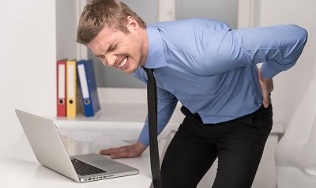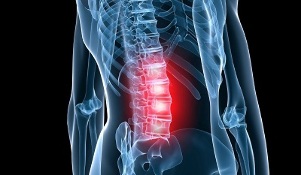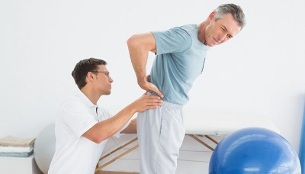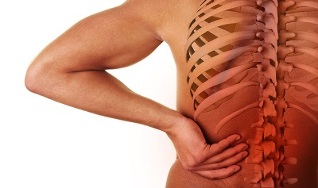Lower back pain most often strikes people after 35 years. In a large number of cases, the disease is associated with spinal deformities and their consequences. Timely visits to the doctor will speed recovery, as the symptoms and treatment of lumbar spine osteochondrosis are interrelated concepts.
The greater the progression of the disease, the more serious the consequences, the more difficult the recovery process.
Signs and symptoms of lumbar spine osteochondrosis

The lumbar spine is located between the sacrum and the thoracic region and consists of five vertebrae connected by intervertebral discs.
The development of osteochondrosis means the use of intervertebral discs, which play a role as shock absorbers during load on the spine. The base of the disc is a gel-like mass, protected by a dense fibrous ring and cartilage tissue, and the inner space is filled with a liquid nucleus pulposus.
As the load on the vertebrae increases, the elasticity and flexibility of the intervertebral disc disappears, as well as its height, and microcrats form in the fibrosus annulus, which eventually causes rupture and damage to the nucleus pulposus.
Tissue destruction is accompanied by pinching of nerve roots located on both sides of the vertebrae and causing severe pain.
The main signs of lumbar osteochondrosis:
- back pain;
- fatigue and depression;
- weakness or excessive muscle tension;
- loss of sensation in limbs, back, or thighs;
- acute pain and cramps or pain in the lumbar region, often radiating to the legs;
- motor function violation.
Against the background of serious vertebral lesions in the lumbar region, other symptoms are observed, most often, dysfunction of other organs - the urinary and reproductive systems, gastrointestinal tract.
Cause
Like most diseases of the musculoskeletal system, osteochondrosis can develop for many reasons. Some of them are rooted in lifestyle and diet, others are formed against the background of physiological features of the body.
Often, treatment of lumbosacral spine osteochondrosis is necessary for athletes, whose backs are not only subjected to constant force loads, but also periodic injuries.

The second category of risky people, people who, based on their profession, spend a lot of time in one position - teachers, hairdressers, cooks, loaders, waiters, programmers, office workers and drivers.
Among other reasons for the development of pathology:
- overweight;
- metabolic disorders;
- incorrect posture, bending;
- genetic predisposition;
- injury;
- bad habits;
- lack of trace elements and vitamins useful in diet;
- development of abnormal musculoskeletal system, flat feet;
- hypothermia;
- lack of mobility, static;
- frequent stress.
All of these factors can affect the elasticity of the intervertebral disc, as they contribute to circulatory disorders or the appearance of nutrient deficiencies that enter the vertebral tissue.
Vertebra is able to perform its function, subject to periodic tissue renewal. If there is a lack of nutrients in the vertebral tissue, either a lack of blood circulation or problems with metabolism, the regeneration process slows down or stops completely. Thus there are changes in drying and dystrophy of the cartilage and fibrous rings of the vertebrae.
Degree of osteochondrosis of the lumbar spine
Depending on the degree of spinal lesion, there are four stages of development of the osteochondric process, which is manifested gradually, as the disease progresses.
First degree
Pathological processes in the spine begin long before their first clinical manifestations. As a result of loss of moisture, the intervertebral disc becomes less elastic. Disk height remains normal. The patient feels discomfort in the lumbar region.
Second degree

Against the background of a lack of moisture, microcrats appear in the fibrosus annulus, and tissue inflammation develops.
The vertebral hook-shaped process gradually increases. Seals grow in cartilage.
A patient complains of back pain radiating to the legs or groin. Motor capability limitations are possible. Damage occurs in the work of internal organs.
Third degree
The integrity of the annulus fibrosus is disturbed, the intervertebral disc protrudes, forming a hernia. Vessels and nerve endings are compressed. There are muscle spasms, pelvic organ dysfunction, sensory disturbances in the lower extremities, prolonged attacks of radiculitis.
Fourth grade
The most difficult, incurable stage in the course of the disease. As a result of the complete destruction of the intervertebral disc, scars form in its place. The vertebral approach is as close as possible and gradually changes shape. With the development of spinal cord compression, paralysis of the lower extremities can occur.
If the treatment of lumbar spine osteochondrosis is not timely, the destruction of the vertebrae will continue and can lead to deformity.
Diagnostics
To identify the disease and determine the exact diagnosis, neurologists use a set of steps - taking anamnesis, physiological examination and apparatus study.
Taking anamnesis
Preparing for patient complaint study:
- reasons for concern;
- location of discomfort;
- duration and intensity of unpleasant sensations;
- duration of illness;
- possible causes of the disease;
- exacerbation frequency;
- factors that cause improvement;
- factors that improve well-being.
In addition, doctors review information on the patient's lifestyle, diet, occupation and rest, the presence of bad habits, hereditary factors and trauma.
Physiological examination

Performed to identify pathological changes and make an early diagnosis.
During the examination, the doctor assesses the patient's motor ability - walking style, posture, amplitude and range of motion. The palpation method examines the state of the muscles - tone, size, volume, presence of cramps.
Sets the level of sensitivity with a slight tingling sensation. Knocking with a hammer makes it possible to identify the pain irradiation zone.
Hardware review
To obtain complete and accurate information on the location of pathology and the degree of tissue damage, doctors use research using various types of medical equipment.
Radiography.Examination of the lumbar spine using X-rays makes it possible to determine the anatomical parameters of the vertebral and intervertebral discs, the tendency to narrow the hole between the bases, the presence of bone growth.
Tomography.The use of electromagnetic waves provides an overview of the area being studied on the screen for further study and analysis of the condition of vessels supplying spinal tissue, nerve processes and intervertebral discs.
CT.X-ray images of several segments of the spine were taken. Pictures are displayed on the monitor to determine the nature of the changes in the vessels, vertebral membranes and spinal cord, marginal growth.
For differential diagnosis, various types of research are used to exclude the pathology of other body systems.
Treatment of lumbosacral spine osteochondrosis
The duration and characteristics of treatment of lumbosacral osteochondrosis depend on the outcome of the diagnostic action. In the early stages of the development of the disease, conservative treatment is indicated. For more complex spinal injuries, surgical intervention is used.
The optimal therapeutic effect is achieved through complex therapy, which involves the use of topical medications, physiotherapy, massage, and gymnastics that improve health.
Medicine
To relieve symptoms, nonsteroidal drugs for internal and external use are prescribed - tablets, injections, ointments. In addition, chondroprotectors, neuroprotectors, diuretics, vitamins, muscle relaxers are used.

Medication allows:
- relieves pain;
- relieves inflammation;
- relax your muscles;
- restores damaged cartilage tissue;
- improves blood circulation;
- reduces swelling;
- increase physical activity;
- normalizes brain nutrition.
For acute pain, novocaine blockers are used, which provide immediate action.
People's solution
Traditional treatments are effective in addition to drug therapy. The main methods of traditional medicine are based on the use of plant materials, animal products and chemicals.
Based on various components, ointments and compresses, decoctions and infusions are prepared, used for internal and external use, as well as for therapeutic baths.
Physiotherapy for lumbar osteochondrosis
Physiotherapy procedures are the best method to restore spinal motor function after suffering from osteochondrosis.
The main methods of physiotherapy are:
- electrotherapy- exposure to weak electrical currents to increase blood circulation in tissues;
- magnetotherapy- the use of magnetic field properties to restore tissue at the cellular level;
- laser therapy- complex activation of biological processes in vertebral tissue and nerve endings;
- shock wave therapy- increased microcirculatory and metabolic processes in affected tissues with exposure to acoustic waves;
- balneotherapy- uses the healing properties of mineral water.
Physiotherapy procedures not only increase the effectiveness of drug treatment several times, but also contribute to the overall healing and strengthening of the body.
Massage for osteochondrosis of the lumbar region
Visiting massage therapy is one of the most enjoyable and effective methods of treating osteochondrosis.
With massage therapy:
- relieves muscle spasms;
- increase blood supply to the affected area;
- increases lymph flow;
- restores atrophic muscles;
- remove movement limit.
Massage is prescribed when the pain syndrome is eliminated.
Recovery gymnastics
The main task of exercise therapy in osteochondrosis is to restore spinal function and correct it. However, you can attend classes only after getting rid of the symptoms of aggravation.
The most effective medical gymnastics methods are:
- charging;
- visits to the gym;
- water therapy, swimming.
Loops can be used for sports at home. Some doctors recommend yoga classes for their patients to restore spinal flexibility.
Exercises to worsen lumbar osteochondrosis
Any exercise for osteochondrosis should be done slowly and without sudden movements.
To strengthen the muscles that support the vertebrae, appropriate exercises are performed while lying on the stomach. In this case, the arm is pulled with a slight stretch, but without tension. Repeat 4 times.
Surgery
Surgery is used to treat the spine in very difficult cases - with significant neurological disorders, as well as with loss of control over stool.
During surgery, the source of the disease is removed and steps are taken to stabilize the spine. The postoperative period lasts for several months.
Why is lumbar osteochondrosis dangerous?

The degenerative changes that occur in lumbar osteochondrosis contribute to the development of many life-threatening diseases. Against the background of intervertebral hernia, protrusion, lumbago and sciatica occur.
Further progression of the disease can lead to intervertebral disc conversation and spinosis formation. In addition to the painful pathology of pain, a person’s motor ability is impaired, resulting in complete disappearance. Paralysis of the lower extremities develops.
If there is severe damage to the lining of the spinal cord, death is inevitable.
Prevention
To avoid damaging changes in the spine, you need to maintain a healthy lifestyle:
- go in for sports - swimming, angry;
- to adhere to a proper balanced and nutritious diet;
- eliminates bad habits;
- maintain posture;
- supports the spine during sleep with an orthopedic mattress.
In addition, it is recommended to avoid hypothermia, weight lifting. Women are advised not to wear high-heeled shoes often.
You can maintain lower back health if you adjust your lifestyle and do not forget the importance of physical activity.





































